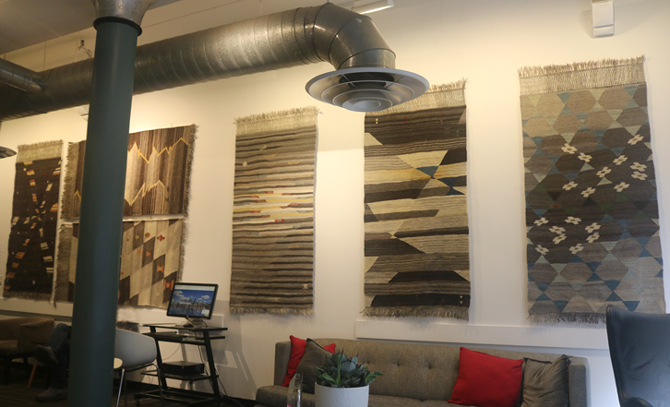
| Iris ©2020 Stanley Bulbach All Rights Reserved |
"From
Sumer to Chelsea" The Fiberart of Stanley Walter Bulbach |
| hosted by Chelsea Eye Ophthalmology 157 West 19th Street New York, New York Open to the Public for viewing except holidays: Mondays — Fridays, 9:00 AM — 5:00 PM Textiles with designs and themes specifically reflecting Manhattan were selected for this art display for the enjoyment of Chelsea Eye Ophthalmology's patients, support staff, and visiting public. For many here in the Chelsea neighborhood in New York City, and for our families and our friends too, Dr Christopher Coad, Dr. Jay Yoon, and the support staff have been protecting our eye health and eye sight. For more on this art project, please see the Album Section |
"The Kilim
Art of Stanley Walter Bulbach" at the Pennswood Art Gallery |
This exhibition premiered Iris, a flying carpet, started in early 2020 as an attempt to explore the extremes and gradations between city and countryside, and between violent storm and resolving rainbow, The extreme range of the handspun lustrous Lincoln longwools were being flaunted here. But by February of 2020, the sudden global pandemic was beginning to impact us all radically, It is unclear what this epidemiological cataclysm still portends. And it is entirely uncertain what message this fatal collision with Nature is delivering to us. For more on this particular carpet project, see the Album Section |
"The Fiber Effect" at The Ukrainian Institute of America |
In early 2022 Bulbach's art was included in the "Fiber Effect, " a group exhibition of four internationally known fiber artists of Ukrainian background in Ukraine and the U.S. Tragically, the exhibition opened on February 24, the very day Russia attacked and invaded Ukraine. For more on this exhibition, see the Album Section |
The Fabric of Civilization: How Textiles Made the World |
| In 2022 the American Tapestry Alliance requested that Bulbach review Virginia Postrel's excellent ground-breaking book on the effect of textiles not only on issues ranging from basic survival through high fashion, but also on textiles' crucial role in international trade and banking over the past five millennia. |
| The ATA censored out a full third of the review on the grounds that it could possibly be "misunderstood." Thus legal permission for ATA's use of the project was withdrawn. However, it can now be read in its uncensored original entirety in the Library Section of this website. |
High Art? Low Art? Or Just a Hobby? |
In June 2020 the American Tapestry Alliance published Bulbach's article, High Art? Low Art? Or Just a Hobby? regarding fiber art policies that brand contemporary fiber art negatively as a hobby. |
Either Exclusivity or Sustainability |
| In February 2020 the British Tapestry Group published Bulbach's article, Either Exclusivity or Sustainability, regarding fiber art policies that impede economic and professional opportunity and perpetuate inaccurate research standards and practices. |
Interwoven Over Millennia: East, West, Ancient and New |
In 2019 from November 18th through December 10th New York University presented Interwoven Over Millennia: East, West, Ancient and New an exhibition of Bulbach's textile art. Photos are posted in the Album Section of this website. The exhibition was at the Richard Ettinghausen Library at the Hagop Kevorkian Center for Near Eastern Studies where Bulbach earned his M.A and Ph.D. (PDF of NYU Announcement.) |
SoHo Salon Featuring Stanley
Bulbach
|
| YouTube currently features a 38 minute video recorded at the March 10th, 2019 presentation at the Louis Mendez Soho Salon in NYC. This video can be viewed at: https://youtu.be/BFeFeztvFp0/ |